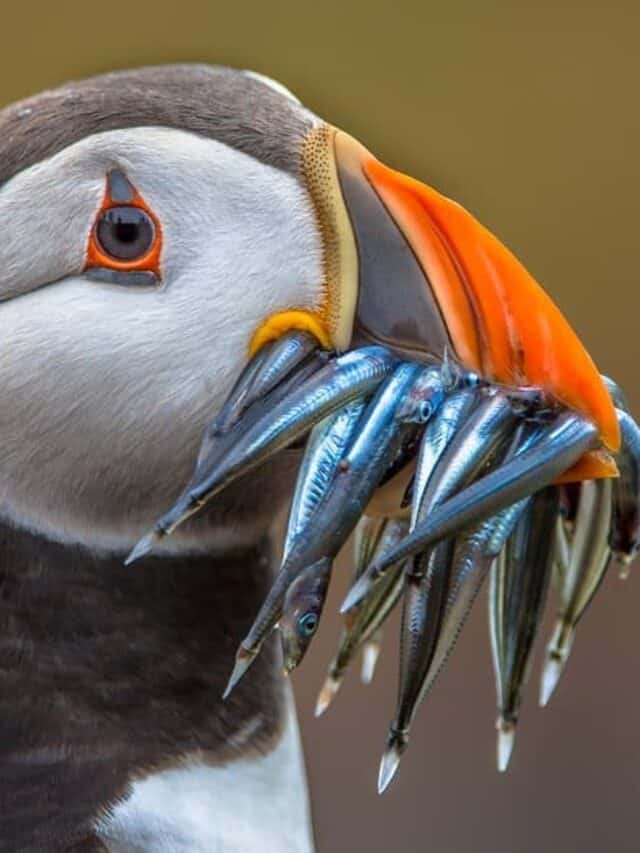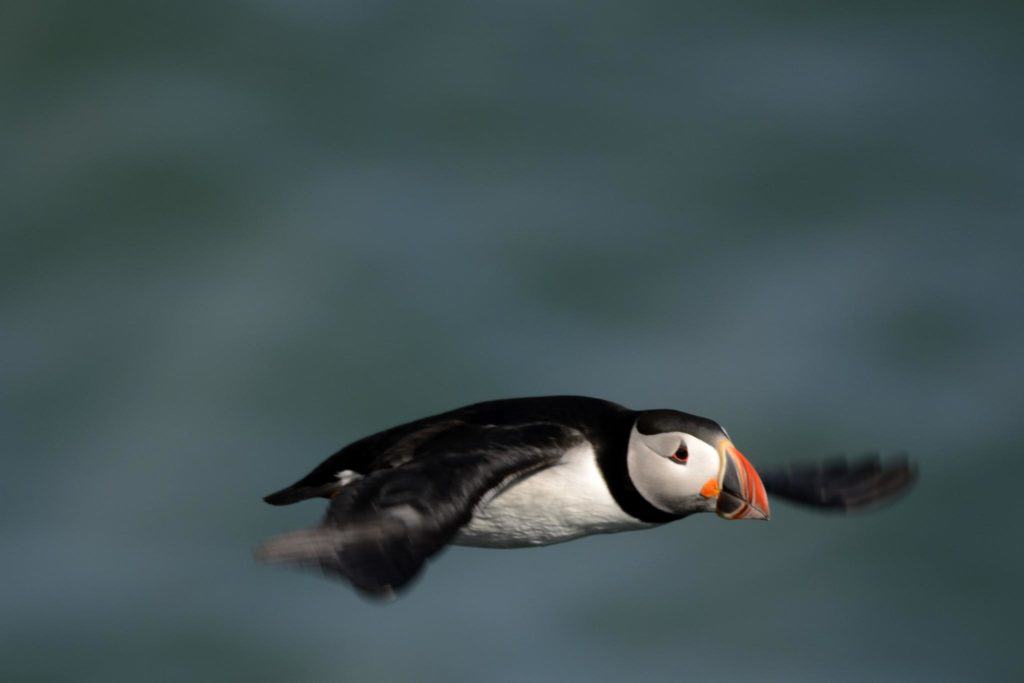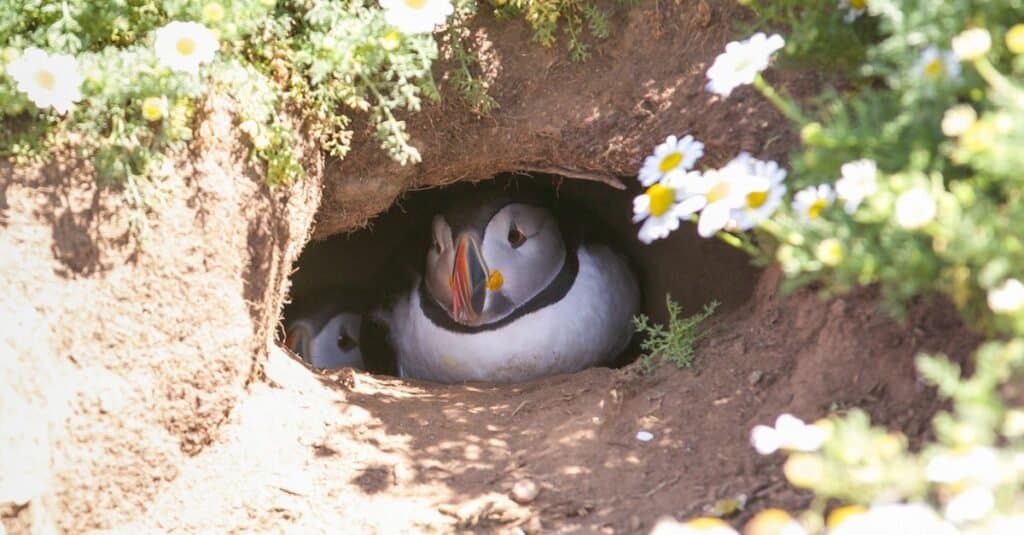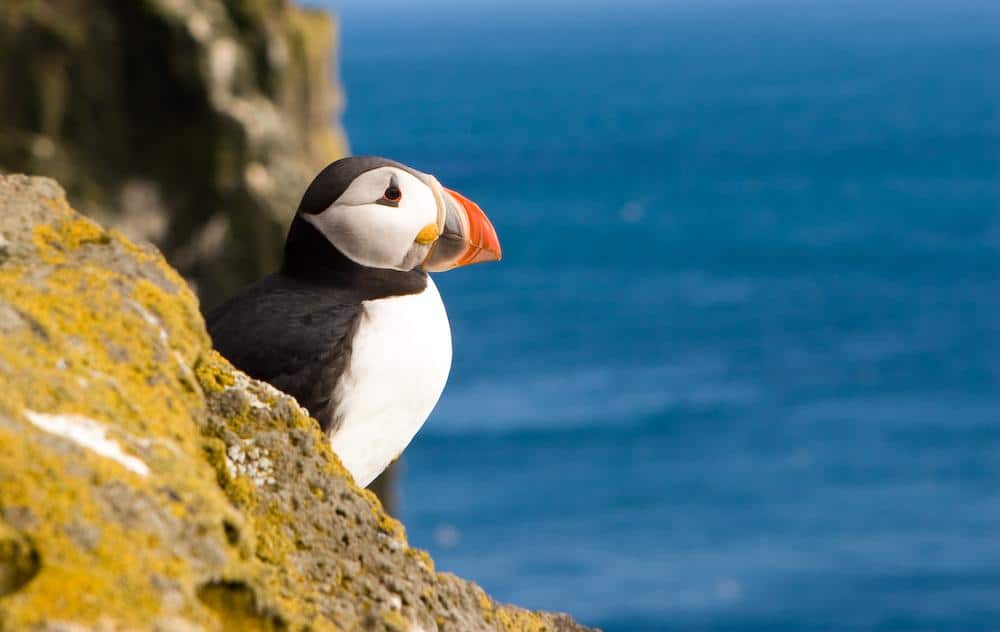Puffins are small seabirds which are members of the auk family. They are found in both the north Atlantic and north Pacific oceans and in places such as Iceland, Norway, Alaska, Colombia, and the UK. Famed for their bright colored bill and their distinctive black and white appearance, they are easily some of the best known birds around – not to mention undeniably cute. With the ability to swim and dive to incredible depths, they are incredibly well adapted to their sea-faring lifestyle. But that’s not all, there is much more to learn about them – including finding out where they nest, how they feed their chicks, and what their affectionate nickname is. So join us as we discover 10 incredible puffin facts!
1. Puffins are also Called “Sea Parrots”
Puffins are some of the most unique seabirds around and they even have a couple of nicknames. The nickname they get called most often is “sea parrot” and when we look at them it’s really not that surprising as they have large, colorful beaks just like parrots. However, their other nickname is “clowns of the sea” because of their bright facial markings. Although this might be an appropriate name there is definitely nothing clown-like about these birds as they are actually incredibly intelligent!
2. Puffins Spend Most of their Lives at Sea
Puffins actually spend the vast majority of their lives at sea where they sit bobbing up and down on the waves. They spend around eight months in total at sea and only return to land to nest in the spring, returning to the sea again in the summer after the chicks have fledged. Although they nest in colonies on the land, puffins are actually solitary birds when they are at sea. They are also virtually silent when at sea too, yet are incredibly vocal when they are on land during the breeding season.
Although it would be easy to assume that they are a sitting target for predators when on the water, their appearance provides them with great camouflage. Their dark upper color hides them from aerial predators as they blend in with the dark ocean, while their light underside makes them difficult to spot from underneath as they blend in with the light shining from above.
3. They Shed the Colorful Part of their Bill
One of the most distinctive features of a puffin is their brightly colored bill. However, it is actually only bright for the duration of the breeding season. This is because they shed the outer layer of it just before winter every year. The remaining bill is a lot smaller and a much duller color (usually grey). Then the following spring it becomes bright again ready for the mating season.
4. Puffins can Hold Several Fish in their Mouth at Once

Many small fish can fit into the large, colorful beak of a puffin.
©Rudmer Zwerver/Shutterstock.com
We’ve already established that puffins have really large and unique bills. Yet did you know that they can hold and carry several fish in it at once? That’s right, puffins can carry up to a seriously impressive twelve fish crossways in their mouth. They are able to do this because of a clever little feature on their tongue. Puffins have a really coarse section on the end of their tongue. This helps them to both hold the fish in place and push them back against the upper part of their bill at the same time. Of course, they’re only able to carry so many because they only catch small fish such as sand eels and herring.
However, having the ability to carry so many fish is actually really important for a puffin because it’s how they take food back to their chicks. Unlike many other birds, puffins don’t regurgitate food for their babies, preferring instead to feed them with freshly caught prey. Therefore, being able to collect many fish in one go saves them from having to make lots of trips back and forth to feed them.
5. They Swim with a Flying Motion
As seabirds which feed on small fish and zooplankton, it’s essential that puffins are able to swim so that they can catch their prey. However, one of the most fascinating things about them is that they actually swim using a flying motion! Puffins have short wings which are particularly suited for swimming. They flap them while underwater to propel themselves forward while using their feet to control their direction. Puffins are incredibly sure, strong swimmers and can even dive to depths of 200 feet deep in search of food.
6. Puffins Can Fly at 55 Miles Per Hour

Although they have to beat their wings a lot to stay in the air, puffins can reach 55 mph!
Although puffins are incredibly graceful under the water, flying is not quite as easy for them in the air. As their wings are so short that they have to beat them around 400 times per minute just to keep themselves in the air. However, despite this they still manage to achieve some pretty impressive speeds and have been recorded flying at 55mph! Puffins typically fly around 30 feet above the water which is higher than many other auks. However, landing is where they have their most trouble. If you didn’t already think puffins are cute then you surely must now, as they tend to crash land. Sometimes puffins just crash into the water and other times they literally tumble across the grass – often knocking over any other puffins that are in their way.
7. Sixty Percent of Puffins Breed in Iceland
There is an estimated 4 to 5 million breeding pairs of puffins in the world. Incredibly around 60% of them breed in Iceland. This means that it is home to more than half of the entire population of puffins. Every April vast numbers of these adorable birds descend on the country to breed. This makes Iceland one of the best places in the world to see them. The summer months between May and August are the best time to see them. After that they return back to the sea for the winter.
8. Puffins Mate for Life

In the bird world it’s not uncommon for some species to choose a new mate every year after undertaking an elaborate courtship ritual, while others choose only one mate and remain loyal to them. Puffins come in the latter category and mate for life – with some pairs staying together for up to 20 years! Puffins only lay one egg per year with both parents sharing the incubation duties. The egg hatches after 36 to 45 days with the baby chick being known as a “puffling”. Both parents then share the responsibility of feeding the puffling until it is ready to fledge.
9. Puffins Dig Burrows

Puffins dig burrows in rocky hillsides to nest in.
©iStock.com/Henfaes
Puffins return to land every spring to nest in huge colonies (the largest single colony consisting of an estimated 4 million birds). However, unlike most birds, puffins don’t build typical nests. Instead, they dig burrows in steep, rocky cliff sides. These burrows are usually dug into the top soil or between rocks in areas which are difficult for predators to get to. Burrows are dug with their feet and beak and can be around 3 feet deep. The burrows are then often lined with grass and leaves ready for the egg to be laid.
10. Puffins are in Decline
Unfortunately, there is a very real risk that puffins might disappear entirely from some popular nesting islands as their population is declining. Their numbers have been dropping for years, with the main threats being declining fish population, climate change, and ground predators in nesting areas. The Atlantic puffin has suffered the most and is classed as a vulnerable species. Breeding populations of Atlantic puffins on some islands in the UK have halved in recent years.
The photo featured at the top of this post is © Giedriius/Shutterstock.com
Thank you for reading! Have some feedback for us? Contact the AZ Animals editorial team.







